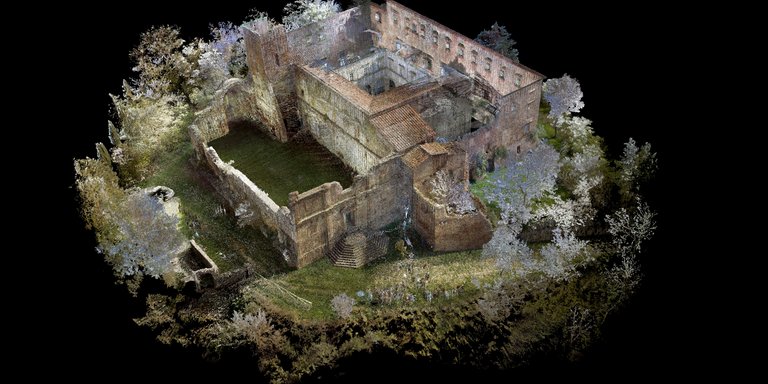Roman amphitheater ruins. Etruscan-era artifacts. Alabaster sculpture studios that preserve their ancient art. All within a walled city that’s been standing since antiquity.
Volterra is a historic settlement in Tuscany, Italy, that dates to the Etruscan and Roman times. Known for its history, art, and architecture, it is a mountaintop town surrounded by ancient walls and has a rich cultural heritage. Within (and outside) of those walls lie many ruins, museums, churches, and generations-old alabaster studios, all of which are worthy of precise documentation to preserve that heritage.
But how much can be preserved? And how much can be discovered about Volterra’s history?
That’s where 3D laser scanning comes in – which uses LiDAR to scan a space and create a digital twin. Case Technologies, Inc., is a company partnered with the Volterra-Detroit Foundation and helps run an annual workshop in Volterra using various laser scanners such as the Leica BLK2GO, Leica BLK360, Leica RTC360, and Leica BLK2FLY. And the Volterra-Detroit Foundation is a public non-profit research-based collaboration originally formed by the alumni and faculty of the School of Architecture at the University of Detroit Mercy to “fund the renovation and adaptation of the building of the former Art School in Volterra (Italy) and for the Volterra International Residential College.”
The Foundation works with the university and other educational institutions to provide students with the chance to immerse themselves in the history, culture, and architecture of Tuscany, specifically Volterra. And for the workshop in 2022, students of the Volterra International Residential College spent a great deal of time scanning the city of Volterra, which already adds to a body of 3D laser scanning and modeling work completed by the foundation in years prior.
Leica Geosystems was called upon to sponsor and provide hands-on help for the workshop in 2022, and with the use of new, autonomous reality capture technologies, the students and teachers of the workshop captured a great deal of the city and the features that make it so unique.
“We’re extremely excited to be working with Leica Geosystems and partnering with them during the workshop,” said Mark Dietrick, Director of Services at Case Technologies and founding officer on the Volterra-Detroit Foundation’s Board of Directors. “We use a lot of their hardware and software technologies, and we’re thrilled to be introduced this year to the BLK2GO and BLK2FLY.”
“It’s exciting that every year we go, there’s something new there,” said Paul Aubin, an officer on the Foundation’s Board of Directors. “With the [Roman] amphitheater which is under excavation, we see something new every year. And this year, we had a great mix of technologies to help us document our year-over-year discoveries.”
BLK2GO in constant motion through the streets
Volterra's major features – both existing and those in ruins – date as far back as thousands of years. As previously documented in case studies featuring architect Elias Logan and his scans of prehistoric through medieval European structures, 3D laser scanning can play a crucial role in historic preservation and archaeological and architectural research. The same holds true for Volterra.
For example, the BLK2GO went everywhere in Volterra, especially due to its portability and ease of use, and it captured anything the researchers needed or wanted. “Someone had the BLK2GO scanning the entire time we walked out of the city down to the monastery, including a walk through the city itself, and just to be able to quickly walk through the streets of Volterra to create a virtual experience is just incredible,” said Dietrick.
The researchers often had multiple scanners in operation, but the BLK2GO took over more labor-intensive tasks where a terrestrial laser scanner would take more time. And the BLK2GO overlapped with all the other scans, giving some connective tissue to the other data captured. The foundation’s goal is to get the entire city mapped and put into a digital twin for posterity. And “visitors” can virtually “walk” from one prominent site in the city to another.
“We have a really huge chunk of the city captured at this point,” Aubin said. “Between the RTC360 on rooftops and the BLK2GO in the streets, we captured most of the walled city.”
BLK2FLY scans a monastery
The BLK2FLY also appeared on scene in Volterra – specifically to scan an abandoned monastery located just outside of the city walls, which, according to Dietrick, was a “highlight of the workshop” and is of great historical significance to Volterra. The roof is missing, although the courtyard is intact – and, according to Mark Dietrick, it was an ideal site for using the BLK2FLY. “It’s a beautiful structure,” Dietrick said, “and we’re so excited to have the data of it.”
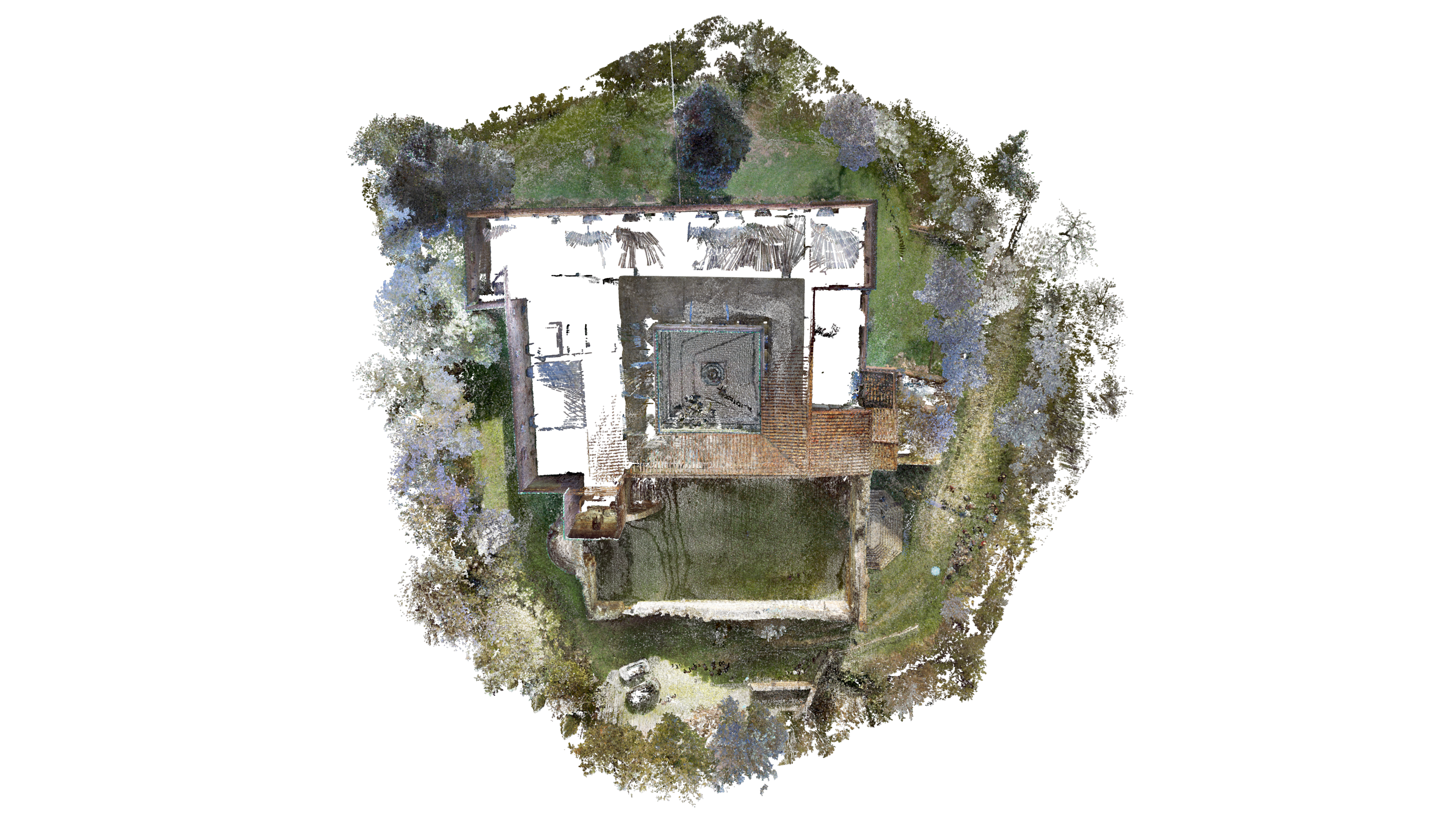
The monastery is also ‘open,’ as the roof is missing. So, the BLK2FLY was able to fly all around the monastery and capture all the external dimensions,
Dietrick said.
“And then we had someone going inside with the BLK2GO,” Aubin added, “which helped us create an even more complete dataset of the entire monastery.” This speaks to the specific combination of scanners in operation as well – the BLK2GO on the ground with the BLK2FLY in the sky creates a cohesive reality capture toolkit for capturing a structure like the Volterra monastery.
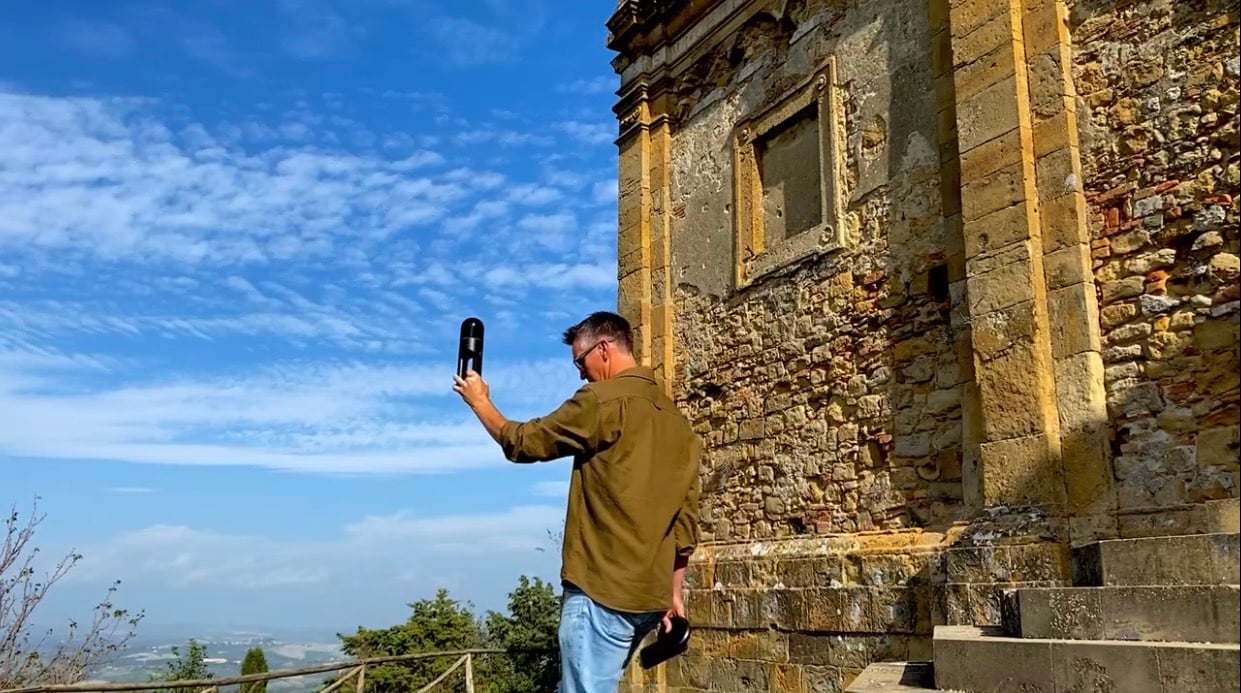
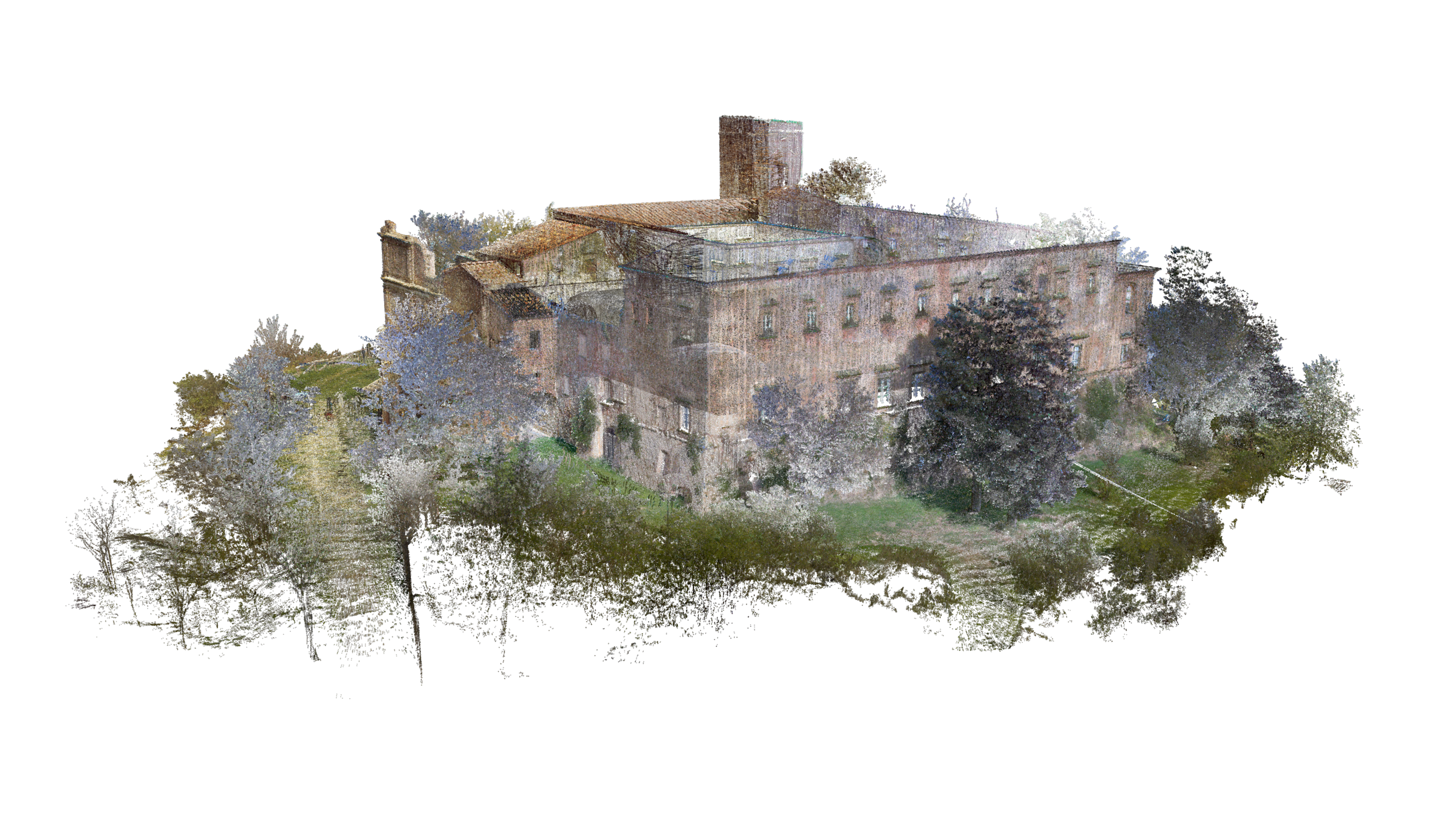
“I am amazed at the ease of use and how quickly we were able to visualize a point cloud on the iPad in only a few minutes after we scanned with the BLK2FLY,” said Touf Hassoun, President and CEO of Case Technologies. “We have a couple of projects back home and I can’t wait to get my hands on a BLK2FLY for those.”
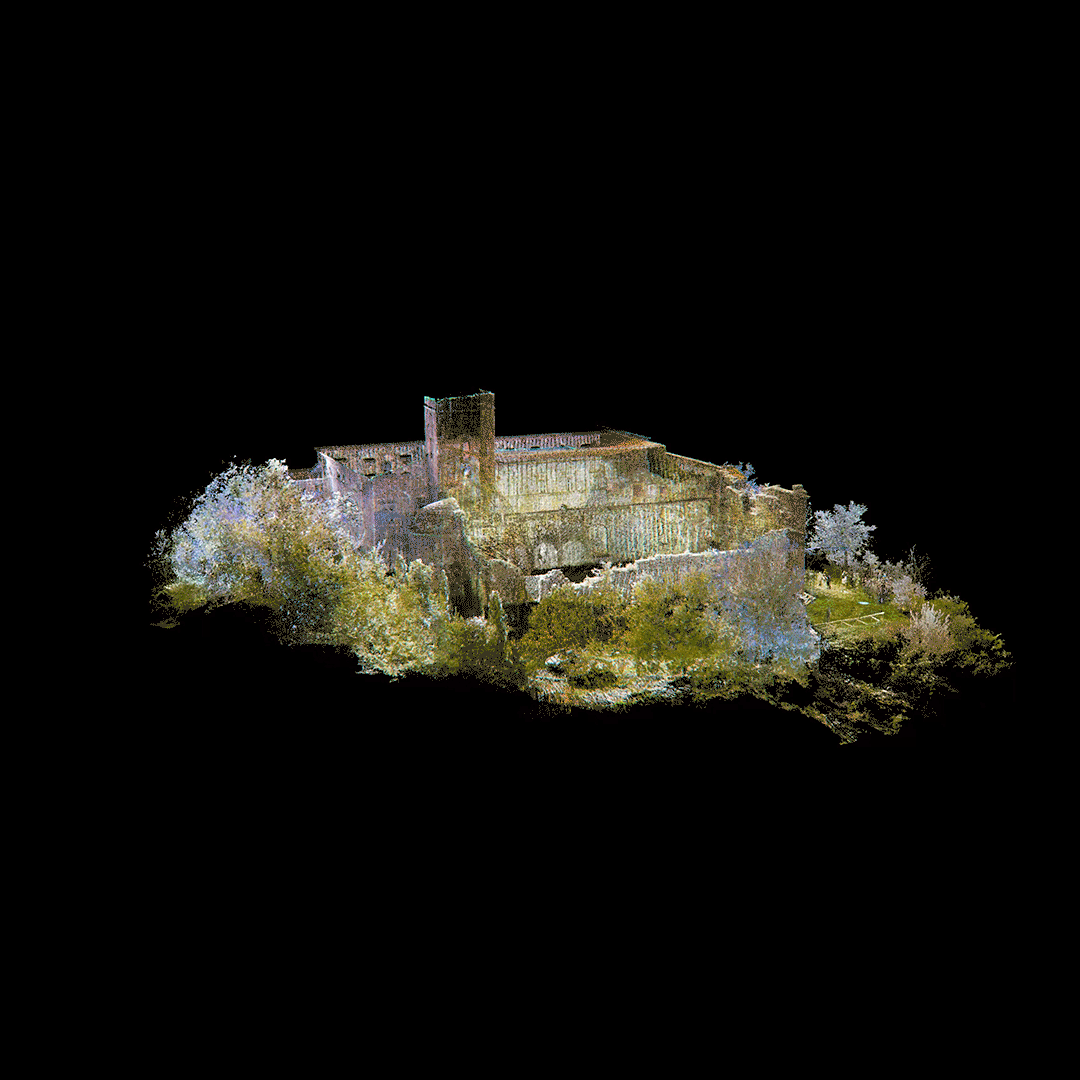
Ancient artifacts on virtual display
One of the most prominent archeological sites in Volterra is its Roman Theater, which the Volterra-Detroit Foundation has worked to scan and model over the years – including creating a 3D model of what the theater might’ve looked like during Roman times. But every year, there’s a new discovery to be made.
The workshop took place during another Volterra-Detroit Foundation sponsored archeological conference, and researchers like Aubin and Dietrick met with an archeologist who was researching the eastern portico of the theater. “There was a statue in the museum that we scanned, which was likely to have been in that eastern portico which he was researching,” Dietrick said. “We were able to create a virtual 3D model of the statue and then ‘place’ it in the virtual model of the eastern portico. It’s beautiful,” Dietrick added, “and we were able to mesh it and get some wonderful visualizations and animations of what this would’ve looked like back during the Roman era.”
Aubin quickly agreed and noted that there was even more to discover this year. “Capturing the amphitheater, since we’ve been there before, we weren’t entirely sure if we’d find something new to capture. But we found significant excavation down into a tunnel, which was so pristinely cleared out, in perfect condition,” he said. “And it was great to be able to scan that and share the experience of being in the monument with the team. It’s one of the most important archaeological discoveries in the last 150 years and we’re so excited to document it."
Preserving an ancient art
A new addition to the workshop’s laser scanning regimen this year was to start exploring generations-old alabaster studios within Volterra. The oldest studios have been in operation since the early 20th century, but the art itself – carving intricate sculptures out of alabaster – dates to Etruscan times, and the artisans often recreate artifacts from the Etruscan era.
Yet there is a distinct possibility that these workshops might not be around for much longer as younger people haven’t taken up the craft as readily as their elders. “Most of the artisans are aging,” Dietrick said, “but to see them and their work, and to capture it for posterity, was very, very special. The impetus for focusing on the alabaster studios this year was that specific predicament – how the art itself is precarious for the city of Volterra.”
But, armed with 3D laser scanners, the workshop came in to preserve, at least digitally, these beloved alabaster studios – including ways of connecting them with the newly-renovated Etruscan Museum.

“We even scanned the Etruscan Museum, which is connected to our scans of the city, and there are hundreds of ornate burial urns carved out of alabaster. The sculptors carved a replica of an urn, featuring Helen of Troy, and this ancient art continues,” Aubin said. “That was just a really cool surprise. Seeing them really apply their craft to something so specific, and something that we captured, too, is remarkable. And we’re hoping that these scans and virtual experiences derived from the data we captured will reignite interest in alabaster sculpture to preserve the art itself.”

The studios are in the city and will also be accessible via the same in–progress virtual tour where one can explore the Etruscan Museum, the Roman Amphitheater, or the streets of Volterra. “That’s the goal,” Dietrick said, “is to document and preserve as much of the city as possible. And year after year, we make more progress to building something special that anyone can access digitally, and for the heritage of Volterra to be preserved.”

 BLK360
BLK360
 BLK2GO
BLK2GO
 BLK2GO PULSE
BLK2GO PULSE
 BLK ARC
BLK ARC
 BLK2FLY
BLK2FLY
 BLK3D
BLK3D
 BLK247
BLK247
 Software
Software
 Accessories
Accessories
